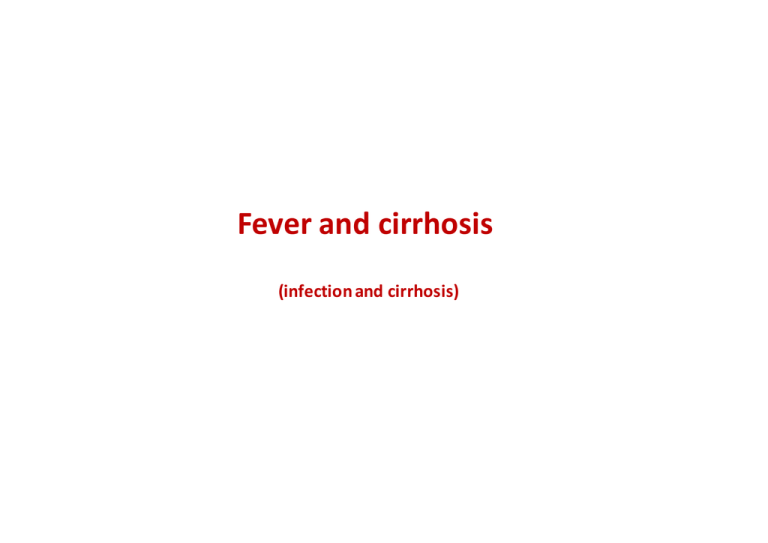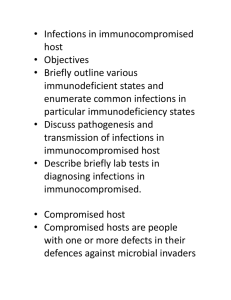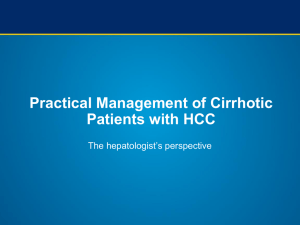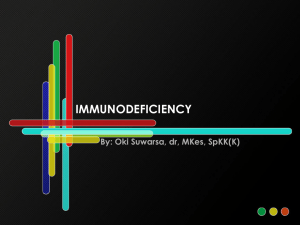Fever and cirrhosis
advertisement

Fever and cirrhosis (infection and cirrhosis) Bacterial Infections in cirrhotics: dimension 20-50% of cirrhotics admitted to hospital have an infection Bacterial infections in cirrhosis are a major cause of: Decompensation Death Fernandez, Hepatology 2002; Arvaniti, Gastroenterology 2010; Fernandez, Hepatology 2012 Diagnosi di infezione batterica in cirrotici al ricovero Pazienti con cirrosi: 404 ricoveri in 361 pazienti Pazienti con cirrosi: 536 % % Urinary tract 26.1 Urinary tract 41 SBP 23.9 Ascites 23 Bacteremia 18.5 Bacteremia 21 Pneumonia 16.3 Pneumonia 17 Soft tissue 4.3 Soft tissue - Other - Other 10.9 Multicenter Italian Database, unpublished Borzio et al, 2001 Some outcome measures 499 in-hospital patients with cirrhosis Length of hospitalization (days): With bacterial infection 15.5 ± 9.9 Without bacterial infection 9.9 ± 7.5 p=0.001 In-hospital mortality With bacterial infection 7 / 88 8.2% Without bacterial infection 11/411 2.7% p=0.03 Gaeta et al. Multicentre Italian database Risk of death in patients with and without infection (in studies reporting complete information on mortality) Arvaniti V. et al. Gastroenterology 2010 ; 139 : 1246-1256 Mortality of patients with cirrhosis after infection Parameter N° of studies N° of pataients Median Mortality Total mortality 178 11.987 38 % - 1 mo 51 2449 30.3% - 3 mo 27 1439 44 % - 12 mo 40 2154 63 % 1978-1999 total mortality 89 4890 47.4 % - 1 mo 21 737 37.3 % - 3 mo 18 578 43 % - 12 mo 25 758 69.7% 2000-2009 total mortality 89 7132 32.3% - 1 mo 29 1621 26 % - 3 mo 9 681 44% - 12 mo 14 634 60% Arvaniti V. et al. Gastroenterology 2010 ; 139 : 1246-1256 Case discussion 3 months before Tot. Bilirubin Ascites 2.08 mg/dL NO On admission Tot. Bilirubin 3.5 mg/dL Ascites mild Case discussion On admission 3 months before Tot. Bilirubin Ascites 2.08 mg/dL NO Tot. Bilirubin 3.5 mg/dL Ascites mild WBC 4900/µL WBC 8400/ µL Neutrophils 3050/µL Neutrophils 5300/ µL Il paziente con cirrosi è immunocompromesso Bonnel, Clinical Gastroenterol Hepatol 2011 Infections occurring during Peg IFN+RBV treatment Ref. Pts n. Type of Pts 1 255 F3-F4 Metavir 17% 12% (24 / 100 pts / yr) Neutropenia only in respiratory infection 2 319 F3-F4 Metavir 34% 23% (41/100 pts / yr) Age> 60 (not neutropenia) 3 119 Cirrhosis 15% 18% None with neutropenia 4 30 OLT listed (50% CTP A) 13% n.a. 5 66 Decompensated cirrhosis 28% 0.45 / 1000pts / mo. OR = 2.95 (0.93-9.3) casecontrol Infections Factors associated CTP C; neutrophils < 900 1. Puoti et al., Antiviral Ther. 2008; 2 Antonini et al., Infection 2008.; 3. Soza et al. Hepatol. 2002 4 Forns et al., J. Hepatol. 2003;.; 5. Iacobellis et al. J. Hepatol 2007 Case discussion On admission 3 months before Tot. Bilirubin Ascites 2.08 mg/dL NO Tot. Bilirubin 3.5 mg/dL Ascites mild WBC 4900/µL WBC 8400/ µL Neutrophils 3050/µL Neutrophils 5300/ µL Creatinine 1.3 mg/dL Creatinine 2.5 mg/dL Cr Clearance 39.26 mL/min Cr clearance 20.6 mL/min Three-month probability of survival of patients with cirrhosis according to the cause of renal failure Martin-Llahi. M. et al. Gastroenterology 2010 Renal failure and bacterial infections in patients with cirrhosis Fasolato, Hepatology 2007 Case discussion Urinalysis Diuresis 600 ml/24h Natriuria 38.7 mEq/24h Cloruria 31.5 mEq/24h Kaliuria 25.0 mEq /24h Microalbuminuria (106 mg/24h) >35 Leukocytes x field 10 RBC x field Case discussion On admission 3 months before Tot. Bilirubin Ascites 2.08 mg/dL NO Tot. Bilirubin 3.5 mg/dL Ascites mild WBC 4900/µL WBC 8400/ µL Neutrophils 3050/µL Neutrophils 5300/ µL Creatinine 1.3 mg/dL Creatinine 2.5 mg/dL Cr Clearance 39.26 mL/min Cr clearance 20.6 mL/min CRP 0.25 mg/dL CRP 5 mg/dL Other sources Enteric bacteria overgrowth Increased intestinal permeability Portal vein Cirrhosis-associated immune dysfunction Bacteremia Translocation to limph nodes Organ localization SBP Mechanisms of bacterial (and their products) translocation Portal hypertension Splancnic vasodilation Disruption of intestinal barrier permeability Increased sympathetic nerve activity Intestinal hypomobility and germ overgrow Translocation Transolacation is associated to increased plasma levels of cytokines (TNFα, IL-6,), MAP-K, “Tempesta citochinica” provocata da prodotti batterici From: Wong, Gut 2006 Bacterial translocation becomes clinically significant when it produces SBP, bacteremia, post-surgical infections Bacterial peptides (Porins; HSP60;) are present in the ascites of afebrile patients with increased TNFα and IFN-gamma concentrations Cano et al. J Mol Med, 2010, e-Pub SBP – A chronic inflammatory disease with flares? bacterial translocation cytokine production nitric oxide production bacterial products which cause: inflammatory response SBP SBP time Clinical risk factors associated with the occurrence of bacterial infections in cirrhosis variceal bleeding prior episode of SBP high Child–Pugh score low ascitic protein levels Gines P,. Hepatology 1990;12:716–724; Gustot T, Hepatology 2009;50:2022–2033 Arvaniti V, Gastroenterology 2010;139:1246–1256; Foreman MG, Chest 2003;124: 1016–1020. Susceptibility to spontaneous bacterial peritonitisare genetics the future ? NOD2 (nucleotide-binding oligomerization domain) variants linked to impaired mucosal barrier may be genetic risk for SBP Mannose-binding lectin deficiency, inducing a defect in opsonophagocytosis of bacteria, confers a higher risk of bacterial infections in patients with cirrhosis Toll-like receptor (TLR)2 polymorphisms are associated with an increased susceptibility towards SBP Appenrodt, Hepatology 2010; 51:1327-33; Altorjav I,. J Hepatol 2010;53:484–491 Nischalke HD,. J Hepatol. 2011; 55:1010-6. Case discussion On admission 3 months before Tot. Bilirubin Ascites 2.08 mg/dL NO Tot. Bilirubin 3.5 mg/dL Ascites mild WBC 4900/µL WBC 8400/ µL Neutrophils 3050/µL Neutrophils 5300/ µL Creatinine 1.3 mg/dL Creatinine 2.5 mg/dL Cr Clearance 39.26 mL/min Cr clearance 20.6 mL/min CRP 0.25 mg/dL CRP 5 mg/dL Body temp 37.5 °C Caratteristiche cliniche delle infezioni batteriche nel cirrotico Deterioramento della funzione epatica Segni e sintomi tipici di infezione Febbre Ittero (assente nel 30-50%) Creat. clearance Leucocitosi neutrofila Encefalopatia (relativa!) Possibile esordio grave: febbre, coagulopatia, coma Cazzaniga, J Hepatol 2009; 51:475-482; Wong, Gut 2005; 54:718-25; Fasolato, Hepatology 2007; 45:223-2 Absence of fever in cirrhotic patients with pneumonia Pneumonia HIV negative (n = 79) (53) T° < 37 26 14 (32,9%) (26,4%) T° > 37 53 39 (67,1%) (73,6%) HIV positive (26) 12 (46,2%) 14 (53,8%) Gaeta, Puoti, in preparation SIRS criteria: less diagnostic accuracy in cirrhosis ? SIRS criteria In cirrhosis • Hyperdynamic circulation leads to tachycardia • Beta-blockers cause a reduced heart rate • Hypersplenism decreases white blood cell count Cazzaniga M,. J Hepatol 2009;51:475–482. Thabut D, Hepatology 2007;46:1872–1882. Therapy The flow chart of empirical treatment Infection considered Microbiological investigations Empirical treatment POS (40%) Modify tx NEG (60%) Continue empirical tx Epidemiology classification Community acquired the diagnosis of infection is made within 48 hours of hospitalization and the patient did not fulfill the criteria for HCA infection Health Care Associated the diagnosis is made within 48 hours of hospitalization in patients with any of the following criteria: (1) had attended a hospital or a hemodialysis clinic, or had received intravenous chemotherapy during the 30 days before infection; or (2) were hospitalized for at least 2 days, or had undergone surgery during the 180 days before infection; or (3) had resided in a nursing home or a long-term care facility. Hospital Acquired the diagnosis of infection is made after more than 48 hours of hospital stay Case discussion Therapy • Plasma expansion ( saline, albumin ) • Antibiotic therapy : During the previous six months the patient had received : • Quinolones • 3rd generation cephalosporins given by GP for UTI and upper respiratory infection Therapy was started with Meropenem 500mg/12h (according to creatinine clearance) and continued for 10 days Systemic antibiotic exposure is a risk factor for bacterial resistance in cirrhosis 169 infectious episodes in 115 patients 70 culture positive infections 33 (47%) antibiotic resistant strains Independent risk factors for resistance Systemic antibiotics in the previous 30 days OR 13.5 (95% CI = 2.6 – 71.6) Nosocomial infection OR 4.2 (95% CI = 1.4 -12.5) Non-adsorbable antibiotics OR 0.4 (95% CI = 0.04 -2.8) Tandon et al. Clin Gastroenterol Hepatol 2012; 10:1291-98 Exposure to antibiotics in the 30 days before the development of infection Tandon et al. Clin Gastroenterol Hepatol 2012; 10:1291-98 Prevalence of gram positive cocci in infections in cirrhotic patients % 90 80 70 60 50 40 30 20 10 0 UTI SBP Bacteremia Tandon, Clin Gastroenterol Hepatol. 2012 Prevalence of E.coli with resistance to quinolones Norfloxacin + Norfloxacin - tot Novella 1997 9/10 (90%) 4/11 (36%) 13/21 Campillo 1998 3/23 (13%) 8/42 (19 %) 11/65 Fernandez 2002 24/37 (65%) 39/135 (29%) 63/172 Cereto 2003 9/13 (69 %) 3/34 (31 %) 12/47 3rd generation cephalosporin susceptible Incidence of 3rd-generation resistant episodes of SBP Ariza et al, J Hepatol 2012; 56 : 825–832 Risk factors for SBP caused by a 3rd-generation cephalosporin-resistant microorganism Ariza et al, J Hepatol 2012; 56 : 825–832 Prevalence of resistant strains among Community acquired 7 – 33% Health care associated 21 – 50% Hospital acquired 40 – 80% Merli, 2012; Ariza 2012 Prevalence of resistance to ESBL among E. coli isolates bacteremias (EARSS 2005) No data < 1% 1-5% 5-10% 10-25% >25% from Quale terapia per le infezioni sostenute da ESBL+? Antibiotici ESBLs Cefalosporine di terza generazione – Cefepime – Fluorochinoloni +/– Piperacillina/tazobactam +/– Carbapenemici +++ Tigeciclina ++ Colistin (for carbapenem resistance) Spontaneous Bacterial Peritonitis (SBP) by a 3rd-generation cephalosporin-resistant microorganism (MRCef) by the days after admission (circles) or days of contact with the health-care system (triangles) Ariza et al, J Hepatol 2012; 56 : 825–832 Risk Factors of Infections by Multiresistant Bacteria in Cirrhosis * * * * Fernandez, Hepatology 2012 Definitions of resistance multidrug-resistant (MDR) The isolate is non-susceptible to at least 1 agent in ≥ 3 antimicrobial categories extensively-drug resistant (XDR) The isolate is non-susceptible to at least 1 agent in all but 2 or fewer antimicrobial categories pandrug-resistant (PDR) Non-susceptibility to all agents in all antimicrobial categories ECDC Expert Panel. Accessible at: http://ecdc.europa.eu/en/activities/diseaseprogrammes/ARHAI Uso di albumina in pazienti cirrotici con infezioni Guevara et al. J Hepatol 2012 vol. 57 j 759–765 Cause di febbre nel cirrotico non solo batteri !! INFLUENZA L’Influenza può causare scompenso nel paziente cirrotico (Duchini, Arch Intern Med, 2000) Elevata mortalità da influenza H1N1 in pazienti cirrotici (3/21 cirrotici vs. 0/27 non cirrotici) (Marzano, J Med Virol 2012) Il vaccino anti-influenzale è sicuro ed immunogeno nei pazienti cirrotici o trapiantati di fegato (Gaeta, Vaccine 2009) Summary & Conclusions Bacterial infection is one of the most frequent cause of decompensation and death in cirrhosis Immune defects, mainly acquired but also genetic, and bacterial translocation are the main mechanisms involved in its pathogenesis The prevalence of infections is likely to be underestimated in clinical practice due to the reduced diagnostic capacity of the standard diagnostic criteria Gram positive and MDR bacteria are increasing etiologic agents Risk factors for 30-day mortality Ariza et al, J Hepatol 2012; 56 : 825–832 Prevalence of gram positive/gram negative bacteria % 70 60 50 40 Gram neg Gram pos 30 20 10 0 All HA Merli, Clin Gastroenterol Hepatol 2010 LPS stimulates hyper-production of TNF-a from monocytes of cirrhotic patients Fernandez J, J Hepatol 2012 Pazienti a rischio di infezione • Cirrosi avanzata (Child-Pugh B/C) • Precedente episodio di peritonite batterica • Emorragia digestiva Profilassi antibiotica nei pazienti con rischio elevato Norfloxacina 400 mg/die Probabilità di sviluppo di peritonite batterica spontanea (%) 100 P < 0.001 Placebo 50 Norfloxacin 0 100 200 300 400 J. Fernandez et al. Gastroenterology 2007 ; 133 : 818-824. days Improved survival after variceal bleeding 80% Child A Child B Child C 70% mortality (%) 60% Predictors of survival 50% 40% •Type of therapy 30% •Antibiotic prophylaxis 20% 10% 0% year: Tx: 1980 •Ballon tamponade 2000 •Vasoactive agents •Endoscopic tx •Antibiotic prophylaxis Carbonell, Hepatology 2004; 40:652-659 Altre infezioni Tubercolosi Stessi fattori di rischio dei pazienti non cirrotici Micosi sistemiche Criptococcosi e Aspergillosi: rischio più elevato nella cirrosi Leishmaniosi Descritta in Italia nelle aree di endemia. Rischio più elevato nella cirrosi


